Kathmandu : After a meeting with the Israeli Prime Minister, U.S. President Donald Trump has announced that the United States will engage in “direct” talks with Iran this coming Saturday. Trump issued a warning, stating that if Tehran fails to reach an agreement, it will find itself in “great danger.”
If direct talks between the two nations occur, it would mark the first official face-to-face negotiations since Trump abandoned the Obama-era nuclear deal seven years ago. However, these talks come at a perilous moment, as The New York Times has noted that Iran lost air defenses around its key nuclear sites due to precise Israeli airstrikes last October. Iran can no longer rely on its proxy forces in the Middle East—Hamas, Hezbollah, and the recently ousted Assad regime in Syria—to threaten retaliation against Israel.
Under orders from Iran’s Supreme Leader Ayatollah Ali Khamenei, Iran has refused to sit for direct nuclear talks with U.S. officials since Trump exited the previous agreement. In this context, a face-to-face negotiation would itself be a significant breakthrough, though it remains highly unlikely that Iran will agree to dismantle its entire nuclear infrastructure. Iran has maintained “threshold” capacity to fuel a bomb within weeks and is estimated to be capable of producing a full weapon in a matter of months. Many Iranians have begun openly discussing the need for the country to develop weapons, especially after last year’s missile exchanges with Israel proved the nation could not adequately defend itself.
Israeli Prime Minister Benjamin Netanyahu, seated beside Trump during a visit to the United States on Monday, stated that any resulting agreement must follow what he called the “Libya model.” This would require Iran to dismantle its entire nuclear infrastructure and ship it out of the country. However, unlike Libya, where much of the nuclear enrichment equipment was never unpacked before being handed over to the United States in 2003, Iran’s nuclear infrastructure has been operational for decades, is spread across the country, and includes many deeply buried underground facilities.
The Times noted that Netanyahu was surprisingly quiet during a lengthy question-and-answer session with reporters, a stark contrast to his demeanor during a Washington visit two months prior. After some introductory remarks, he largely remained a spectator as Trump berated European nations for “ripping us off” and threatened additional punitive tariffs if China did not reverse its retaliatory tariff threats by Tuesday, according to an interesting observation by The Times.
Netanyahu left the Oval Office without a public commitment from Trump to lift the 17 percent tariffs imposed on Israel, one of the key objectives of his trip, alongside securing additional weapons for the war against Hamas in Gaza and Israeli military operations in the West Bank. If the two leaders discussed Israeli or joint Israeli-U.S. military options against Iran’s main nuclear sites, they gave no indication of it during their public remarks.
The closest Trump came to addressing this was: “I think everybody agrees that doing a deal would be preferable to the obvious thing. And the obvious thing I don’t want to be involved in, or frankly Israel doesn’t want to be involved in either, if they can avoid it.”
He added, “So we’ll see if this can be saved, but it’s becoming a very dangerous area, and hopefully those talks will be successful.”
Citing three Iranian officials familiar with the talks with the U.S., The Times reported that Trump’s description of the upcoming negotiations was not entirely accurate. According to them, Iran’s understanding was that discussions in Oman would begin as indirect talks, with negotiators from each country in separate rooms and Omani diplomats shuttling messages back and forth.
This arrangement would resemble the indirect talks conducted by the Biden administration, where mediators were European officials. However, the Iranian officials said that if the indirect talks progressed well, Tehran would be open to direct talks with the United States.
Trump is attempting to resolve a problem he partly created himself. The 2015 nuclear deal saw Iran ship out 97 percent of its enriched uranium, leaving only a small amount in the country and retaining the equipment necessary to produce nuclear fuel. President Barack Obama and his top aides said at the time that the deal was the best outcome they could achieve. However, it left Iran with the equipment and nuclear know-how to rebuild after Trump withdrew from the agreement, and today it possesses enough fuel to produce six nuclear weapons in a relatively short time.



COMMENTS